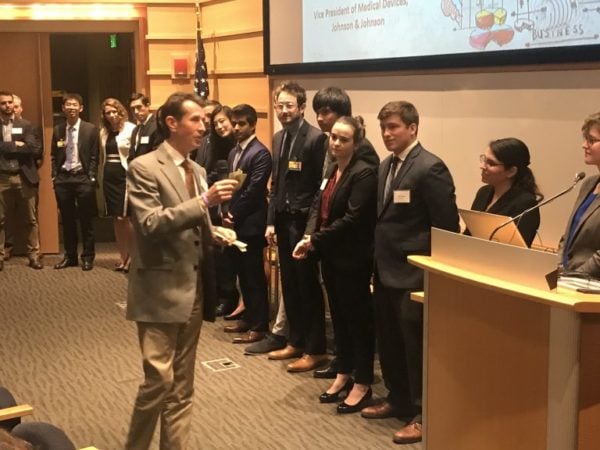Students showcase design projects and compete in annual Shark Tank contest

The Johns Hopkins Department of Biomedical Engineering’s Center for Bioengineering Innovation and Design held its fifth annual Fall Healthcare Innovation Showcase and Shark Tank on December 11 at the Johns Hopkins School of Medicine campus. During the event, students presented their ongoing work with Johns Hopkins clinical experts to develop innovative solutions to unmet health care needs.
To kick off the event, undergraduate students from the BME Design Teams course presented short videos of their projects. The audience voted for their favorite videos, which featured designs for new technologies to monitor spinal cord blood flow, deliver therapies directly to brain tumor sites, and improve outcomes for a type of skull surgery known as craniosynostosis in infants.
After the video presentations, a panel of Johns Hopkins biomedical engineering alumni shared advice on bringing medical technology products to market. Hosted by Brian Stansky of Johns Hopkins Technology Ventures, the panel consisted of David Narrow ’13, Kevin Colbert ’14, Kevin Keenahan ’14, and Clay Andrews ‘17. Panel members drew from their experiences of creating startup companies based on their own CBID projects.
Following the discussion, CBID master’s students participated in a competition inspired by the American television show Shark Tank and its international counterpart, Dragons’ Den. Four teams were given seven minutes each to convince a panel of industry experts—the sharks—to invest in their medtech business concepts. The sharks then provided feedback and asked questions about each team’s product and business strategy. After the presentations, each shark invested in their favorite teams, awarding up to $400.
This year’s sharks included Robert Storey, managing director of the MVR Company; Martha Connolly, Johns Hopkins BME alumna ’80; Brian Stansky, director of JHTV’s FastForward; Moss Amer, analyst for Maryland Venture Fund; and Paul Fearis, founding partner and CEO of Clinvue, who has sponsored the event for the past five years.
“We’re incredibly fortunate to have Paul and his company support the CBID program,” said Youseph Yazdi, executive director of CBID. “Paul not only supports this event, but is also one of our top-ranked instructors.”
William Cohn, professor of surgery at Baylor College of Medicine and vice president for medical devices at Johnson & Johnson, closed the event by sharing his experiences in medtech innovation during a keynote talk.
“Dr. Cohn’s lecture was an inspiration for our students, but also for the clinicians and scientists in the audience,” said Yazdi. “He’s an incredibly humble and creative inventor, but also a leader in clinical practice, education, and industry. A rare combination.”
Based on the feedback they received during the event, the master’s student teams will spend the upcoming spring semester modifying their designs. Teams will present their polished prototypes at the Department of Biomedical Engineering’s annual Design Day in early May. Read more about their designs below:
Eyedea – Corneal transplants offer enormous potential to restore sight to patients with impaired vision, but the process used to harvest donated corneas is inefficient and often results in damage to the delicate tissues. Eyedea is streamlining this processing step to increase the quality and supply of corneal tissues available for transplant procedures.
PneumoNIX Medical – A common complication of lung biopsy procedures is pneumothorax, which occurs when air leaks into the chest cavity, causing the lung to collapse. PneumoNIX Medical is designing a solution to anticipate and reduce the risk of pneumothorax by preventing the entry of air during lung biopsy.
SurgiSight – When surgical patients are discharged from the hospital, they receive limited instruction on caring for their incision wounds and monitoring for signs of infection. SurgiSight is designing a mobile application that allows discharged surgical patients to communicate with their healthcare providers for better wound reporting and diagnosis of surgical site infections.
CytoSage – To make a successful diagnosis, pathologists require high-quality tissue samples. Patients must sometimes undergo multiple procedures if the tissue obtained during the initial biopsy was inadequate. CytoSage is developing a system to provide rapid, on-site evaluation of biopsies, and notify pathologists when quality samples are obtained.
